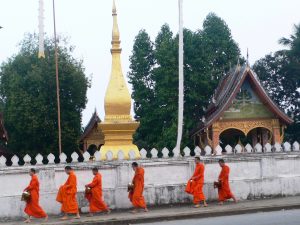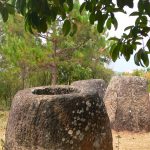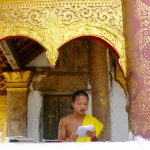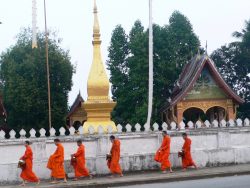Keeping The Secret Alive
Will the CIA be great again?

By Larry Joseph Calloway ©
A Great Place to Have a War: America in Laos and the Birth of a Military CIA by Joshua Kurlantzick (Scribner, 2017)
 Laos is a great place to be a tourist. It has Luang Prabang, with its French colonial architecture and Buddhist monasteries along a simple historic main street. It has the Plain of Jars, with its mysterious artifacts among American bomb craters on a depopulated plateau. It has the Hmong people of the Colin Cotterill’s “Dr. Siri” mystery novels. It has communist Vientiane, linked by a Mekong bridge with the bright lights of capitalist Thailand. It has rolling mountains and calm rivers and deep pools.
Laos is a great place to be a tourist. It has Luang Prabang, with its French colonial architecture and Buddhist monasteries along a simple historic main street. It has the Plain of Jars, with its mysterious artifacts among American bomb craters on a depopulated plateau. It has the Hmong people of the Colin Cotterill’s “Dr. Siri” mystery novels. It has communist Vientiane, linked by a Mekong bridge with the bright lights of capitalist Thailand. It has rolling mountains and calm rivers and deep pools.
So forget the war. The Lao people have or – as in Vietnam – seem to have forgotten. It ended more than 40 years ago. But Joshua Kurlantzick’s book is no travel guide. It is the most comprehensive documentation yet of the “secret war,” whose political secrets have already been told in bits and pieces. (Kurlantzick uses many of the same journalistic clips that I used in writing inspired by travels in laos beginning ten years ago.)
But he also is informed by newly declassified CIA documents, to which as a specialist in Southeast Asia for the Council on Foreign Relations he is well placed for access. The justification for the book is in the subtitle: “America in Laos and the Birth of a Military CIA.” The secret war in Laos is the archetype for what the CIA has been doing ever since – in Afghanistan, Nicaragua, Chile, Somalia, Kosovo, Iraq, Yemen. And now, Kurlantsick says, the Predator drone program “allows the president to conduct operations anywhere.”
Well, why not? There is a consensus about threats to national security. Obama started the drone-supported special forces war. Trump has an implied mandate to continue it without restraint. Why not? Kurlantzick answered in an op ed piece promoting his potential bestseller in the Washington Post: “These paramilitaries are almost totally unaccountable, and unaccountability encourages rash, even criminal, behavior, including disdain for civilian lives, torture and other abuses.” We now have a government under Trump whose rhetoric proudly forewarns all these things.
The CIA, created under Truman in 1947 as a spy agency, began to go paramilitary in the kingdom of Laos at the end of the Eisenhower administration. The torch was passed to Kennedy, who in the third month of his administration addressed the nation standing before a map of Southeast Asia and pointed out the landlocked geographical strip between Thailand and Vietnam. The U.S. intelligence “elite” (Kurlantzick’s term) under Eisenhower generalized the Cold War enemy as international communism, and the president announced the corresponding “domino theory:” namely, that Thailand and other countries in the sphere of Mao’s China and the neighborhood of Ho Chi Minh’s North Vietnam could collapse in a chain reaction.
 The first domino was not South Vietnam but landlocked Laos, which provided access from north to south. The nation of little more than 2 million population was involved in civil war lite among a crowd of antagonists: the royal government corrupted by American aid, the Pathet Lao inspired by the Vietnam communists and probably aided by China, the neutralist nationalists rejecting both sides, and the ethnic minorities. Of the minorities the most strident were the Hmong hill tribes that had migrated into the Laos highlands from southern China in the early 19th century and fought with the French colonists against Uncle Ho. They were – and continue to be – hated by the Lao majority.
The first domino was not South Vietnam but landlocked Laos, which provided access from north to south. The nation of little more than 2 million population was involved in civil war lite among a crowd of antagonists: the royal government corrupted by American aid, the Pathet Lao inspired by the Vietnam communists and probably aided by China, the neutralist nationalists rejecting both sides, and the ethnic minorities. Of the minorities the most strident were the Hmong hill tribes that had migrated into the Laos highlands from southern China in the early 19th century and fought with the French colonists against Uncle Ho. They were – and continue to be – hated by the Lao majority.
The unchallenged Hmong leader was Gen. Vang Pao, a restless and superstitious fighting man adored by American military people for his bravery. He was supported abundantly by the CIA. He and two colorful American agents are the main protagonists in the book. Tony Poe (he shortened his last name from something like Polansky) was a Marine combat veteran who began training hill tribes in modern warfare. Poe loved a good fire fight and was reputed to collect bags of enemy ears. Bill Blair was an Army combat veteran who began his mission by training Thai police officers to be paratroopers, presumably but falsely for domestic safety. They would suffer overwhelming losses in the Laos war. Kurlantzick, who interviewed Blair before his sad death in Texas, begins the book with a colorful account of Blair’s ceremonial promise to Vang Pao that the U.S. government would always provide refuge for the Hmong. It was a non-binding promise, as it turned out. Some 400,000 Hmong, persecuted and hunted, remain in Laos.
By 1963, Vang Pao commanded 20,000 guerilla fighters and the CIA was spending $500 million a year (equivalent of $4 billion now) in Laos. And the whole business was being kept secret. Congress was willingly deceived, its constitutional authority to declare war ignored. U.S. military officers were restricted to drinking and whoring in Thailand and advising in South Vietnam. The media were intimidated and compromised. It was not until 1969 that the New York Times exposed the “secret war.”
Kurlantzick quotes Richard Helms, director of the CIA from 1966 to 1973, saying: “Laos was the war we won.” This is hard to believe, considering the absence of any identifiable victory laurels beyond body counts. With the “forgotten” war memorialized mostly by bomb casings converted to flower planters, the U.S. military is ridiculed (as in the story I heard about the farmer who, envious of a neighbor’s deep and perfectly circular water pool, complained, “Why didn’t the Americans make a fish pond for me?”)

The joke is about the B-52’s that sowed bombs like seeds from 35,000 feet. Craters are everywhere on the Plain of Jars, where everything less substantial than the stone jars themselves was destroyed. People hid in caves by day and farmed for their subsistence at night. The population of the plateau was reduced from 150,000 to 9,000, according to Kurlantsick’s journalistic sources.
But the CIA did not do the bombing. The American military did it from bases in Thailand. The CIA ordered air support for Hmong operations, but the eventual massive bombing was a campaign directed from the White House – namely, by Kissinger and Nixon. In the first year of the Nixon administration the bombing of Laos exploded from no more than 20 bomber runs a day to 300 a day, and it increased in subsequent years.
Kurlanzick says, “Massive bombing seemed to hold an appeal to Nixon beyond its direct merits as a policy tool.” The White House tapes reveal conversations in which Nixon, posing in public as a peacemaker, talks in private of “going for broke” in the bombing and having a will “in spades” to use the power of commander in chief that his predecessors lacked. The tragic irony of this cynicism is that Nixon knew the bombing was ineffective. In a note discovered recently by Bob Woodward, Nixon told Kissinger, “We have had 10 years of total control of the air in Laos and Vietnam. The result – Zilch.”
There is a horrifying zilchness in the moral distance of this isolated, insecure, often drunk, anti-liberal Republican president’s reckoning of Lao deaths and suffering. He once asked Kissinger, “How many did we kill in Laos?” His esteemed counselor responded about 15,000. Kurlantzick quotes this taped exchange without comment on Kissinger’s dismissive response, but it is clear from other accounts of the Lao bombing that the secretary of state-national security advisor knew better. William Sullivan, the U.S. ambassador who ran the secret war from Vientiane until 1968, was close enough to Kissinger to be his representative at the Paris peace talks.
The casualty rate in Laos – about 10 per cent of the population or 200,000 – was higher than for any other group in the last 75 years of the world at war. And the deaths and injuries in Laos continue due to unexploded cluster bombs. Christopher Hitchens in his indictment of Kissinger (“callous indifference to human life and human rights,” “depraved realpolitik”) called the main publication of the Council on Foreign Relations, Foreign Affairs, a “house organ of the State Department,” where Kissinger, its former secretary, is still revered. That would explain why Kurlantzick lets him off easy.
But for the others – CIA directors and out-of-control field agents, false diplomats, fumbling pseudo-military spooks, propagandizing presidents, willfully blind Senators – there is no hiding place down there anymore.

